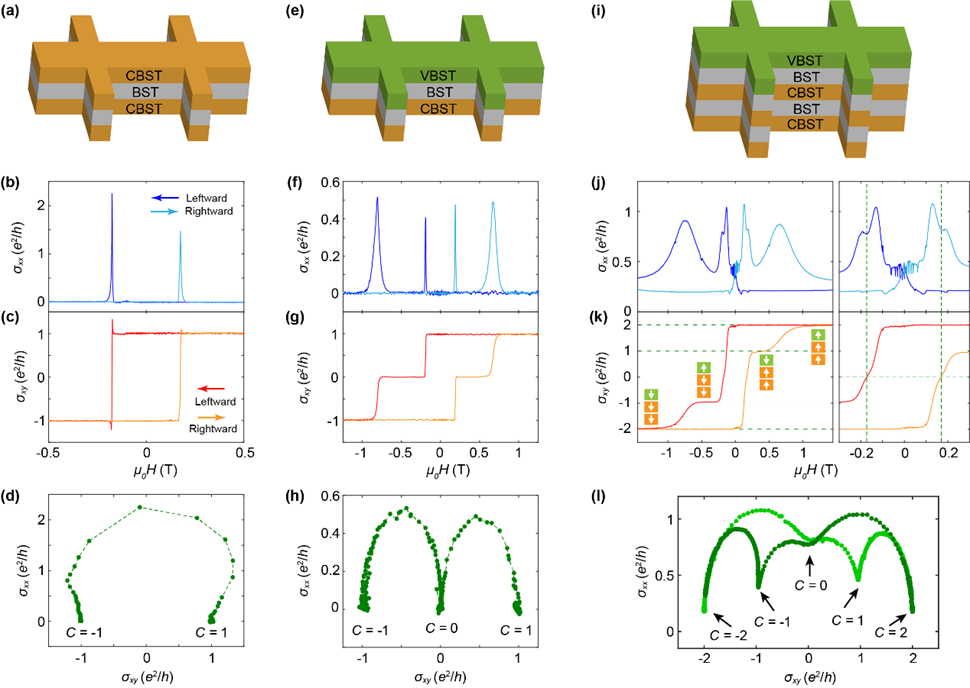Low-Dimensional Quantum Materials Group Achieves Progress in Quantum Anomalous Hall Effect
2024/05/13
Recently, the Low-Dimensional Quantum Materials Group at the Beijing Academy of Quantum Information Sciences (BAQIS), in collaboration with the Department of Electrical Engineering at the University of California, Los Angeles, the Department of Physics at the University of Science and Technology of China, and the Department of Physics at Fuzhou University, reported the observation of the Chern number-tunable quantum anomalous Hall (QAH) effect. The results were published in Physical Review B (Letter) on May 6, 2024, titled "Tuning the number of chiral edge channels in a fixed quantum anomalous Hall system."
QAH insulators have dissipationless chiral edge states running at their boundaries, and the unique topological properties of these states can be applied to facilitate the implementation of topological quantum computing and low-power electronic devices. The Chern number of a quantum anomalous Hall insulator represents the number of its chiral edge states. In high Chern number QAH insulators, there exist multiple chiral edge states. Although the QAH effect with different Chern numbers has been realized in distinct QAH multilayer films, the Chern number, or the number of chiral edge states, is fixed within a single sample. To change the Chern number, one has to alter the structure and composition of the sample, which greatly limits the application of high Chern number QAH insulators in electronic devices.
The researchers grew QAH multilayer films consisting of magnetic topological insulators and topological insulators via molecular beam epitaxy. By tuning the magnetism of the individual magnetic layer in the five-layer QAH multilayer, they revealed QAH effects with different Chern numbers within the same sample. Theoretical calculations elucidated the contribution of each layer to the Chern number in the multilayer film structure, and the phase diagram of the QAH multilayer was revealed. This study demonstrates an additional degree of freedom for tuning the chiral edge channels in QAH insulators. This tunability offers an extra dimension for the implementation of QAH-based multichannel dissipationless transport.

FIG. 1. (a) Schematic layout of a 3-QL-CBST/5-QL-BST/3-QL-CBST multilayer. (b), (c) Field dependence of σxx and σxy of the CBST/BST/CBST multilayer measured at 100 mK. (d) Flow diagram of (σxy, σxx) of the CBST/BST/CBST multilayer. (e) Schematic layout of a 3-QL-VBST/5-QL-BST/3-QL-CBST multilayer. (f), (g) Field dependence of σxx and σxy of the VBST/BST/CBST multilayer measured at 100 mK. (h) Flow diagram of (σxy, σxx) of the VBST/BST/CBST multilayer. (i) Schematic layout of a 3-QL-VBST/5-QL-BST/3-QL-CBST/5-QL-BST/3-QL-CBST multilayer. (i), (k) Field dependence of σxx and σxy of the VBST/BST/CBST/BST/CBST multilayer measured at 50 mK. Panels on the right are the zoomed in plots around the C = 0 states. (l) Flow diagram of (σxy, σxx) of the VBST/BST/CBST/BST/CBST multilayer.
The first authors of the paper are Associate Researcher Peng Deng from BAQIS and Associate Professor Yulei Han from Fuzhou University. Corresponding authors include Peng Deng, Professor Zhenhua Qiao from the University of Science and Technology of China, and Professor Kang L. Wang from the University of California, Los Angeles. Other collaborators include Assistant Researcher Su Kong Chong from BAQIS. This work was supported by the National Natural Science Foundation of China and the Beijing Natural Science Foundation.
Link: https://journals.aps.org/prb/abstract/10.1103/PhysRevB.109.L201402
 中文
中文 Email
Email QCloud
QCloud Log in
Log in
